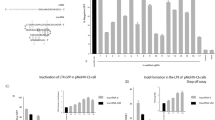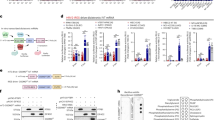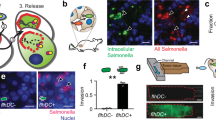Abstract
RNA interference (RNAi) has been established as an important research tool that carries great potential for gene therapy. However, targeted induction of RNAi in vivo has met with significant challenges. In this study, a novel pSLS plasmid capable of expressing short hairpin RNAs (shRNAs) was transformed into attenuated Salmonella enterica serovar typhimurium strain 7207 (SL). In vitro infection studies with the transformed S. enterica containing pSLS (SL-pSLS-CAT) demonstrated that expression of shRNA targeting the CTNNB1 gene induced potent and specific silencing of CTNNB1 expression in cultured SW480 cells. CTNNB1 knockdown in SW480 cells was associated with markedly reduced proliferation and cell death compared with that of control infected cells. In addition, SL-pSLS-CAT-mediated CTNNB1 knockdown markedly reduced tumor growth in SW480 xenograft mice. These tumors exhibited reduced levels of CTNNB1, as well as c-Myc and cyclin D1. Finally, SL-pSLS-CAT treatment also resulted in reduced expression levels of these genes in polyps, mucosal tissues and in small intestines of APCMin mice. Taken together, these data suggest that attenuated shRNA-expressing Salmonella may be a powerful new tool for in vitro gene silencing, functional genomics, and the development of RNAi-based anticancer or human immunodeficiency virus therapeutics.
This is a preview of subscription content, access via your institution
Access options
Subscribe to this journal
Receive 12 print issues and online access
$259.00 per year
only $21.58 per issue
Buy this article
- Purchase on Springer Link
- Instant access to full article PDF
Prices may be subject to local taxes which are calculated during checkout








Similar content being viewed by others
References
Timmons L, Fire A . Specific interference by ingested dsRNA. Nature 1998; 395: 854.
Broeke A, Burny A . Retroviral vector biosafety: lessons from sheep. J Biomed Biotechnol 2002; 2003: 9–12.
Guarino A, Lo Vecchio A, Canani RB . Probiotics as prevention and treatment for diarrhea. Curr Opin Gastroenterol 2009; 25: 18–23. Review.
Brenner DM, Moeller MJ, Chey WD, Schoenfeld PS . The utility of probiotics in the treatment of irritable bowel syndrome: a systematic review. Am J Gastroenterol 2009; 104: 1033–1049.
Fedorak RN . Understanding why probiotic therapies can be effective in treating IBD. J Clin Gastroenterol 2008; 42 (Suppl 3 Pt 1): S111–S115.
Rosenberg SA, Spiess PJ, Kleiner DE . Antitumor effects in mice of the intravenous injection of attenuated Salmonella typhimurium. J Immunother 2002; 25: 218–225.
Theys L, Barbe S, Landuyt W, Nuyt S, Van Mellaert L, Wouter B et al. Tumor-Specific gene delivery using genetically engineered bacteria. Current Gene Ther 2003; 3: 207–221.
Zhao M, Yang M, Li XM, Jiang P, Baranov E, Li SK et al. Tumor-targeting bacterial therapy with amino acid auxotrophs of GFP-expressing Salmonella typhimurium. PNAS 2005; 102: 755–760.
Low KB, Ittensohn M, Le T, Platt J, Sodi S, Amoss M et al. Lipid A mutant Salmonella with suppressed virulence and TNFalpha induction retain tumor-targeting in vivo. Nat Biotechnol 1999; 17: 37–41.
Yang N, Zhu X, Chen L, Li S, Ren D . Oral administration of attenuated S. typhimurium carrying shRNA-expressing vectors as a cancer therapeutic. Cancer Biol Ther 2008; 7: 145–151.
Xu DQ, Zhang L, Kopecko DJ, Gao L, Shao Y, Guo B et al. Bacterial delivery of siRNAs: a new approach to solid tumor therapy. Methods Mol Biol 2009; 487: 161–187.
Xiang S, Fruehauf J, Li C . Short hairpin RNA–expressing bacteria elicit RNA interference in mammals. Nat Biotechnol 2006; 24: 696.
Aouadi M, Tesz GJ, Nicoloro SM, Wang M, Chouinard M, Soto E et al. Orally delivered siRNA targeting macrophage Map4k4 suppresses systemic inflammation. Nature 2009; 458: 1180–1184.
Pascopella L, Raupach B, Ghori N, Monack D, Falkow S, Small PL . Host restriction phenotypes of Salmonella typhi and Salmonella gallinarum. Infect Immun 1995; 63: 4329–4335.
Wang X, Goode EL, Fredericksen ZS, Vierkant RA, Pankratz VS, Liu-Mares W et al. Association of genetic variation in genes implicated in the β-catenin destruction complex with risk of breast cancer. Cancer Epidemiol Biomarkers Prev 2008; 17: 2101–2108.
Saldanha G, Ghura V, Potter L, Fletcher A . Nuclear β-catenin in basal cell carcinoma correlates with increased proliferation’. Br J Dermatol 2004; 151: 157–164.
Takeuchi A . Electron microscope studies of experimental Salmonella infection. I. Penetration into the intestinal epithelium by Salmonella typhimurium. Am J Pathol 1967; 50: 109–136.
Carter PB, Collins FM . The route of enteric infection in normal mice. Exp Med 1974; 139: 1189–1203.
Bliska IB, Galan IE, Palkow S . Signal transduction in the mammalian cell during bacterial attachment and entry. Cell 1993; 73: 903–920.
Grillot-Courvalin C, Goussard S, Huetz F, Ojcius DM, Courvalin P . Functional gene transfer from intracellular bacteria to mammalian cells. Nat Biotechnol 1998; 16: 862–866.
Mathew E, Hardee GE, Bennett CF, Lee KD . Cytosolic delivery of antisense oligonucleotides by listeriolysin O-containing liposomes. Gene Ther 2003; 10: 1105–1115.
Levine MM, Ferreccio C, Black RE, Germanier R . Large-scale field trial of Ty21a live oral typhoid vaccine in enteric-coated capsule formulation. Lancet 1987; 1: 1049–1052.
Simanjuntak CH, Paleologo FP, Punjabi NH, Darmowigoto R, Soeprawoto, Totosudirjo H et al. Oral immunisation against typhoid fever in Indonesia with Ty21a vaccine. Lancet 1991; 338: 1055–1059.
Media Contact: Grossman C. Cequent Files its First IND with FDA: CEQ508, a tkRNAi Drug Candidate in Oncology. 12 November 2009.
Kochi SK, Killeen KP, Ryan US . Advances in the development of bacterial vector technology. Expert Rev Vaccines 2003; 2: 31–43.
Acknowledgements
We thank Thu Nguyen for her instruction of in vivo experiment; Dr Johannes Fruehauf, Dr Andrew Keates and Dr John R Nambu for their help in English language; Natalya Bodyak for animal feeding and genotyping work; and Dr Cengz for reformating the figures.
Author information
Authors and Affiliations
Corresponding author
Ethics declarations
Competing interests
The authors declare no conflict of interest.
Rights and permissions
About this article
Cite this article
Guo, H., Zhang, J. & Inal, C. Targeting tumor gene by shRNA-expressing Salmonella-mediated RNAi. Gene Ther 18, 95–105 (2011). https://doi.org/10.1038/gt.2010.112
Received:
Revised:
Accepted:
Published:
Issue Date:
DOI: https://doi.org/10.1038/gt.2010.112
Keywords
This article is cited by
-
Attenuated Salmonella carrying siRNA-PD-L1 and radiation combinatorial therapy induces tumor regression on HCC through T cell-mediated immuno-enhancement
Cell Death Discovery (2023)
-
Bacteria-mediated delivery of RNAi effector molecules against viral HPV16-E7 eradicates oral squamous carcinoma cells (OSCC) via apoptosis
Cancer Gene Therapy (2019)
-
Salmonella-Mediated Cancer Therapy: Roles and Potential
Nuclear Medicine and Molecular Imaging (2017)
-
Engineering Salmonella as intracellular factory for effective killing of tumour cells
Scientific Reports (2016)
-
Assessment of navigation control strategy for magnetotactic bacteria in microchannel: toward targeting solid tumors
Biomedical Microdevices (2013)



